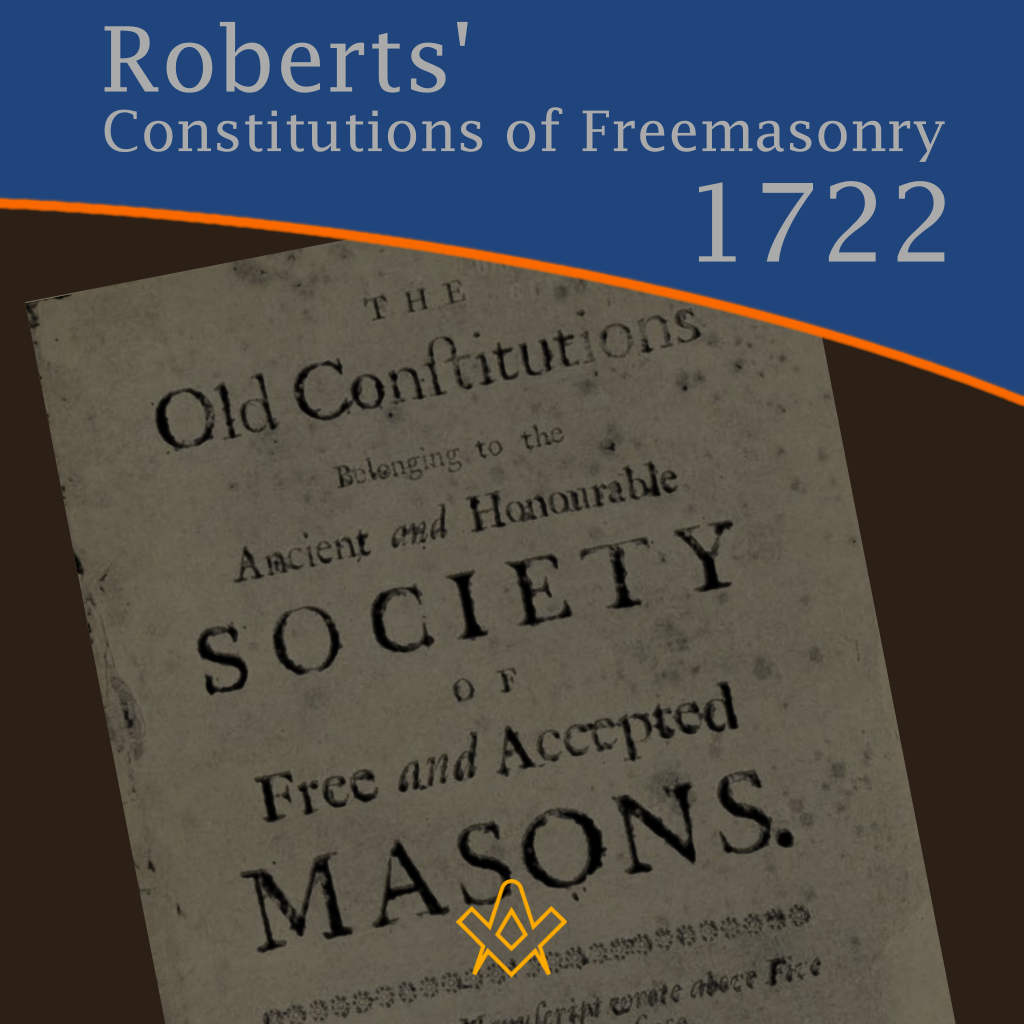Is the first of this class, as respects priority of publication, and is entitled the “Old Constitutions Belonging to the Antient and Honourable Society of Free and Accepted Masons.
Taken from a Manuscript wrote above Five Hundred Years since. (London, Printed and sold by J. Roberts, in Warwick Lane, MDCCXII.) It is the earliest printed work known relating exclusively to Free-masonry, and is without doubt a transcript of the “Harleian MS. , No. 1942”, (M.) which may have been copied from a much older document, but certainly not of the age claimed by Roberts.
The “New Articles”, (said to have been agreed on at a General Assembly held 8th December, 1663) were subsequently printed in the “Book of Constitutions” by the Rev. Dr. Anderson, and others from A.D. 1738 to A.D. 1784!
Some have declared that this pamphlet by Roberts, mentions several Masonic Degrees of a speculative and philosophical character, but such a statement is contrary to fact, as no work was issued by any Grand Lodge or Society under the Title of Freemasons, and which practised certain degrees, called Masonry, until the year A.D. 1723.
The 2nd Edition of this curious little Book was published last year by Bro. R. Spencer, London, in his valuable reprints of the “Old Constitutions of the Freemasons” from A.D. 1722 to 1730.
William James Hughan, (1841-1911) wrote of the Roberts’ Manuscript in his “The old charges of British Freemasons”:
Published a year before Anderson’s Constitutions, there are only two extant copies of J. Roberts’ Constitutions: one in the library of the Grand Lodge of Iowa, and Robert J. Blackham tells us in Apron Men: The Romance of Freemasonry (1933), that one was owned by Sir Lacon Threlford and on loan to the United Grand Lodge of England library.
Roberts’ Constitutions is easily the most priceless Masonic literary possession in America, and was published in facsimile by the National Masonic Research Society, with an introduction by Masonic scholar Joseph Fort Newton in 1916.
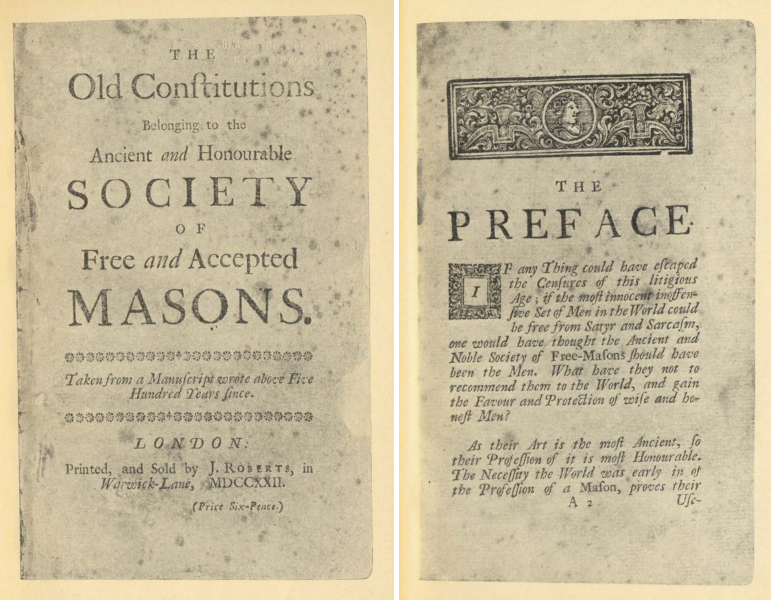
THE Old Constitutions Belonging to the Ancient and Honourable SOCIETY OF Free and Accepted MASONS. – Taken from a Manuscript wrote above Five Hundred Years since. – LONDON: Printed, and Sold by J. Roberts, in Warwick-Lane, MDCCXXII.
IMAGE LINKED: National Masonic Research Society, with an introduction by Masonic scholar Joseph Fort Newton in 1916. Attribution 4.0 International (CC BY 4.0)
THE PREFACE
IF any Thing could have escaped the Censures of this litigious Age; if the most innocent inoffensive Set of Men in the World could be free from Satyr and Sarcasm, one would have thought the Ancient and Noble Society of Free-Masons should have been the Men.
What have they not to recommend them to the World, and gain the Favour and Protection of wise and honest Men?
As their Art is the most Ancient, so their Profession of it is most Honourable. The Necessity the World was early in of the Profession of a Mason, proves their Usefulness; for I believe it will not be doubted, that Men had Houses before they had Cloaths, as they had Altars before they had Temples.
Cain built a City, and Abel, no doubt, built an Altar, when he offered his Sacrifice to the LORD.
THUS useful, and thus ancient, it cannot be wondered if the World honour’d them with all the Tokens of Respect, which in those Days they were capable of, and perhaps more than we have yet an Account of.
THESE Honours, and this Respect, it cannot be doubted brought Men of Value among them, who thought it not below them to wear the Badge of the Society, and to acknowledge themselves to be Favourers of their Greatness, as they were Lovers of Art.
UNDER the Protection of such Persons of Honour and Interest, it is not to be express’d what mighty Fabricks they have erected, what glorious Buildings they have rais’d, from the Temple of Solomon to the magnificent Pile of St. Peter’s at Rome.
HOW this Society has been preserv’d; How regularly they have acted; on what wholesome Laws they have been founded, and how carefully they have observ’d and regarded those Laws, as the just Cement of the Society, that is partly to be seen in this Tract, and it will speak for itself.
NOR is their Value lessen’d or abated at all by the Dust and Scandal rais’d by any Men against them, or by the Freedom they have taken to banter and rally them. The Dirt thrown at them flyes back on those that cast it, and the Honour of the Society of Free-Masons remains entire. So that none of the Persons of Honour who have lately grac’d the Society with their Presence, have yet seen any Reason to be asham’d of them, or to withdraw their Protection from them.
MUCH more might be said to their Honour, but the following Piece of Antiquity is sufficient, and will give every Reader an Authentick Account of them. It has yet seen the World but in Fragments, but is now put together as a Thing of too much Significancy to pass our Observation, and which will effectually vindicate the Ancient Society of Free-Masons from all that has or can be said against them.
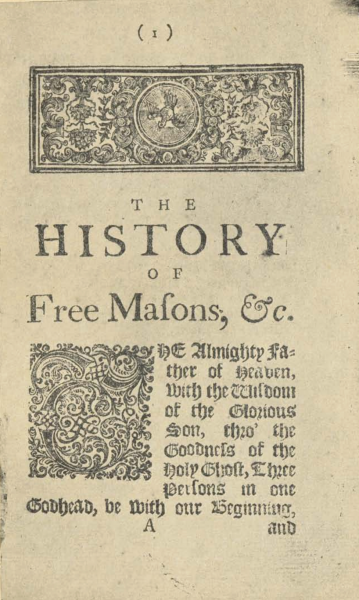
THE HISTORY OF Free Masons, &c.
IMAGE LINKED: National Masonic Research Society, with an introduction by Masonic scholar Joseph Fort Newton in 1916. Attribution 4.0 International (CC BY 4.0)
The Almighty Father of Heaven, with the Wisdom of the Glorious Son, thro’ the Goodness of the Holy Ghost, Three Persons in one Godhead, be with our Beginning, and give us his Grace so to govern our Lives, that we may come to his Bliss, that never shall have end. Amen.
GOOD Brethren and Fellows, our Purpose is to tell you how, and in what manner the Craft of Masonry was begun, and afterwards how it was founded by worthy Kings and Princes, and other wise Men, hurtful to none, and also to them that be true, we will declare doth belong to every Free Mason to keep firm good Faith, if you take Heed thereunto it is well worthy to be kept, which is contain’d in the Seven Liberal Sciences as follows, viz.
Imprimis, It’s Grammar that teaches a Man to speak truly, and write truly.
II. It’s Rhetorick that teaches a Man to speak fair, and in subtle Terms.
III. It’s Logick that teaches a Man to discern Truth from Falshood.
IV. It’s Arithmetick that teaches a Man to Accompt, and reckon all manner of
Numbers.V. It’s Geometry that teaches Mett and Measure of any Thing, and from thence
cometh Masonry.VI. It’s Musick that teacheth Song and Voice.
VII. It’s Astronomy which teacheth to know the Course of the Sun, Moon, and
other Ornaments of Heaven.
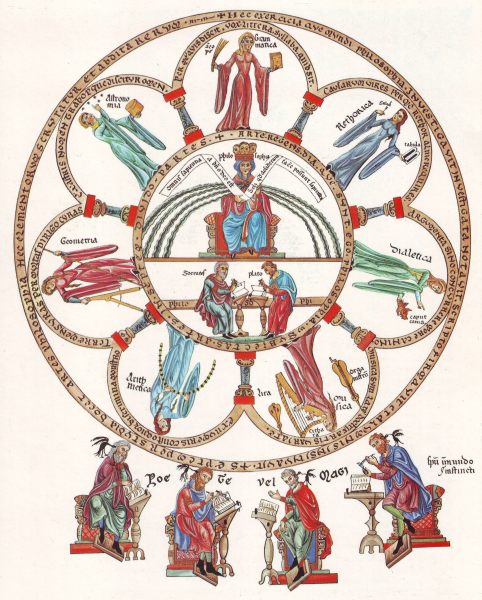
The Seven Liberal Arts.
IMAGE LINKED: wikimedia Attribution 4.0 International (CC BY 4.0)
Note, I pray you, That these Seven are contain’d under Geometry, for it teacheth Mett and Measure, Ponderation and Weight for every Thing in and upon the whole Earth for you to know; that every Craftsman works by Measure; He or She that buys or sells, is by Weight or Measure; Husbandmen, Navigators, Planters, and all of them, use Geometry; for neither Grammar, Rhetorick, Logick, nor any other of the said Sciences can subsist without Geometry, ergo, most worthy and honourable.
You ask me how this Science was invented; my Answer is this, That before the General Deluge, which is commonly called Noah’s Flood, there was a Man called Lamech, as you may read in the Fourth Chapter of Genesis, who had two Wives;
the one called Ada, the other Zilla;by Ada he begat two Sons, Jabal and Jubal; by Zilla he had one Son called Tubal, and a Daughter called Naamah.
These four Children found the beginning of all Crafts in the World: Jabal found out Geometry, and he divided Flocks of Sheep, and Lands; he first built a House of Stone and Timber.
Jubal found out Musick; Tubal found out the Smith’s Trade or Craft, also of Gold, Silver, Copper, Iron and Steel; Naamah found out the Craft of Weaving.
And these Children knew that GOD would take Vengeance for Sins, either by Fire or Water, wherefore they did write there Sciences, that they had found, on two Pillars of Stone, that they might be found after that GOD had taken Vengeance; the one was Marble, that would not burn, the other was Latress [1], that would not drown in Water; so that the one would be preserved, and not consumed, if GOD would any People should live upon the Earth.
It resteth now to tell you how these Stones were found, whereon the said Sciences were written, after the said Deluge: It so pleased God Almighty, that the Great Hermarmes [2], whose Son Lunie was, who was the Son of Sem, who was the Son of Noah.
The said Hermarmes was afterwards called Hermes, the Father of Lunie, he found one of the two Pillars of Stone. He found these Sciences written thereon, and taught them to other Men.
And at the Tower of Babylon, Masonry was much made on; for the King of Babylon, who was Nemorth3, was a Mason, and serv’d the Science; and when the City of Ninevah, and other Cities of the East, should be built, Nemorth sent thither Threescore Masons, at the Desire of the King of Ninevah; and when they went forth, he gave them a Charge after this manner, That they should be true one to another, and love one another, that he might have Worship by them in sending them to his Cozen the King.
He also gave them Charge concerning their Science; and then it was the first time that any Mason had Charge of his Work. Also Abraham, and Sarah his Wife, went into Egypt, and taught the Egyptians the Seven Liberal Sciences; and he had an ingenious Schollar called Euclydes, who perfectly learned the said Liberal Sciences.
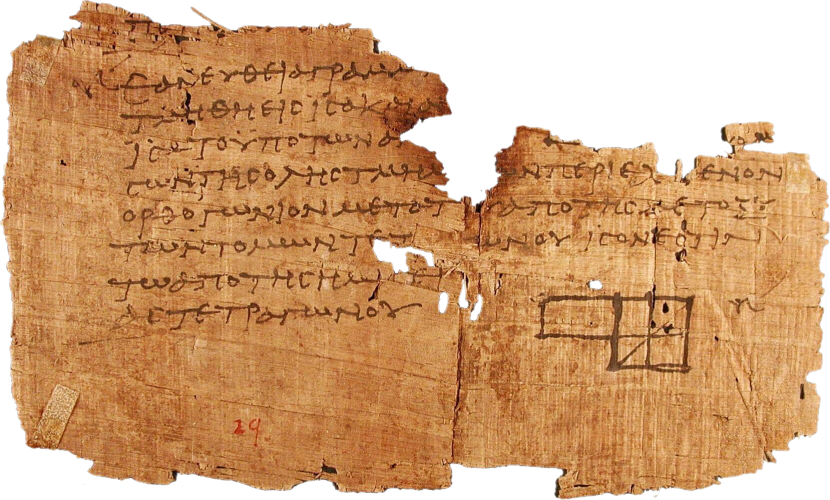
Papyrus Oxyrhynchus 29 illustrating Proposition 5 from Book II of Euclid’s Elements in Greek [1]
IMAGE LINKED: wikimedia Attribution 4.0 International (CC BY 4.0)
[1] (P. Oxy. 29) is a fragment of the second book of the Elements of Euclid in Greek. It was discovered by Grenfell and Hunt in 1897 in Oxyrhynchus; they published the full text ‘Oxyrhynchus Papyri I’ in 1898. ‘The fragment contains the statement, in Greek, of Proposition 5 from Book II of Euclid’s Elements.’ (Otto Neugebauer in The Exact Sciences in Antiquity (p. 58) and was originally dated to the end of the third century or the beginning of the fourth century, although more recent scholarship suggests a date of 75–125 CE. It is housed in the library of the University of Pennsylvania (E 2748).
It happen’d in his Days, the Lords and States of the Realm had so many Sons unlawfully begotten by other Men’s Wives, that the Land was burthen’d with them, having small Means to maintain them withal; the King understanding thereof, caused a Parliament to be called or summoned for Redress, but being so Numberless that no Good could be done with them, he caused Proclamation to be made through the Realm, that if any Man could devise any Course how to maintain them, to inform the King, and he should be well rewarded;
whereupon Euclydes came to the King, and said thus, My noble Sovereign, if I may have the Order of Government of those Lords Sons, I will teach them the Seven Liberal Sciences, whereby they may live honestly like Gentlemen, provided that you will grant me Power over them by virtue of your Dominion;
which was immediately effected, and there Euclydes gave them those Admonitions following:
I. To be true to their King.
II. To be true to the Master they serve.
III. To be true, and love one another.
IV. Not to miscall one another, &c.
V. To do their Work so duly, that they may deserve their Wages at their Master’s Hands.
VI. To ordain the wisest of them Master of the rest of the Work.
VII. To have such reasonable Wages, that the Workman may live honestly, and
with Credit.
VIII. To come and assemble together in the Year, to take Council in their Craft how they may work best to serve their Lord and Master, for his Profit, and their own Credit, and to correct such as have offended.
Note, That Masonry was heretofore term’d Geometry, and sithence the Children of Israel came to the Land of Bethest, which is now called Emens, in the Country of Jerusalem, where they began a Temple, which is now called the Temple of Jerusalem:
And King David loved Masons well and cherish’d them, for he gave them good Payment, and gave them a Charge, as Euclydes had given them before in Egypt, and further, as hereafter followeth; and after the Decease of King David, Solomon his Son finished the Temple that his Father had began;
He sent for Masons of divers Nations, to the Number of Four and Twenty Thousand, of which Number Four Thousand were elected and created Masters and Governors of the Work.
And there was a King of another Region or Country, called Hiram, who loved well King Solomon, and he gave him Timber for the Work; and he had a Son called Amon, and he was Master of Geometry, and he was chief Master of all his Masons of Carving-Work, and of all other Work of Masonry that belong’d to the Temple, as appears by the Bible in Lib.
Regum Cap. 4. And King Solomon confirmed all Things concerning Masons that David his Father had given in Charge; and then Masons did travel divers Countries, some to augment their Knowledge in the said Art, and to instruct others.
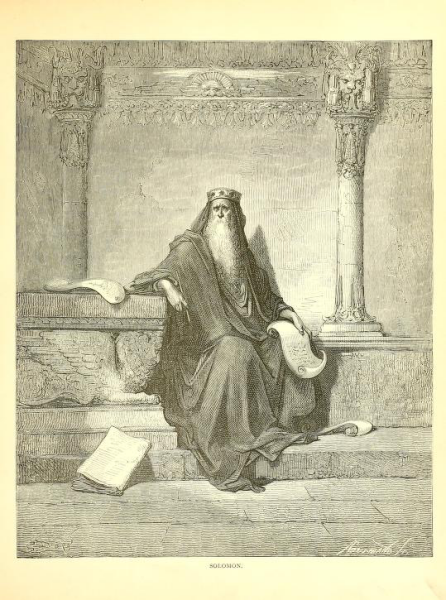
King Solomon
IMAGE LINKED: wikimedia Attribution 4.0 International (CC BY 4.0)
And it happen’d that a curious Mason named Memongrecus, that had been at the building of Solomon’ s Temple, came into France, and taught the Science of Masonry to the Frenchmen; and there was a King of France called Carolus Martel, who loved greatly Masonry, who sent for the said Memongrecus, and learned of him the said Sciences, and became one of the Fraternity; and thereupon began great Works, and liberally did pay his Workmen: He confirm’d unto them a large Charter, and was yearly present at their Assembly, which was a great Honour and Encouragement unto them; and thus came the Science into France.
The Knowledge of Masonry was unknown in England until St. Alban came thither, who instructed the King in the said Science of Masonry, and also in Divinity, who was a Pagan:
He walled the Town now called St. Alban; he became in high Favour with the King, insomuch that he was Knighted, and made the King’s Chief Steward, and the Realm was governed by him under the said King.
He greatly cherished and loved Masons, and truly paid them their Wages Weekly, which was 3 s. 6 d. the Week.
He also purchased for them a Charter from the King to hold a General Assembly and Council Yearly. He made many Masons and gave them such a Charge as is hereafter declared.
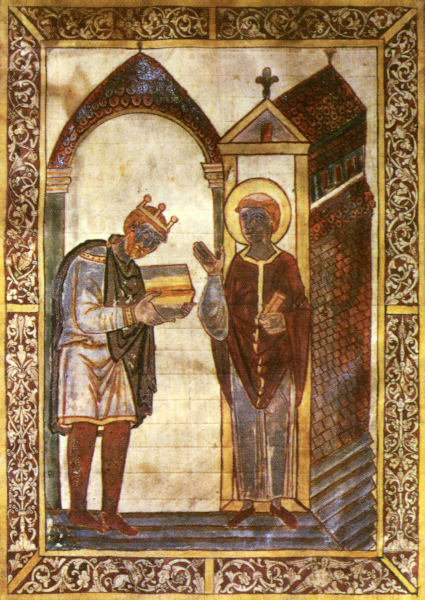
Frontispiece of Bede’s Life of St Cuthbert, showing King Æthelstan (924–39) presenting a copy of the book to the saint himself. MS 183, f.1v at Corpus Christi College, Cambridge.
IMAGE LINKED: wikimedia Attribution 4.0 International (CC BY 4.0)
It happen’d presently after the Martyrdom of St. Alban, who is truly term’d England’s Proto-Martyr, that a certain King invaded the Land, and destroy’d most of the natives by Fire and Sword, that the Science of Masonry was much decay’d, until the Reign of King Athelston, which some write Adleston, who brought the Land to Peace and Rest, from the insulting Danes.
He began to build many Abbies, Monasteries, and other Religious Houses, as also Castles and divers Fortresses for Defence of his realm. He loved Masons more than his Father; he greatly studied Geometry, and sent into many Lands for Men expert in the Science.
He gave them a very large Charter, to hold a Yearly Assembly, and Power to correct Offenders in the said Science;
– and the King himself caused a General Assembly of all Masons in his Realm, at York, and there made many Masons, and gave them a deep Charge for Observation of all such Articles as belonged unto Masonry, and delivered them the said Charter to keep:
– and when this Assembly was gathered together, he caused a Cry to be made, that if any of them had any Writing that did concern Masonry, or could inform the King of any Thing or Matter that was wanting in the said Charge already delivered, that they or he should shew them to the King, or recite them to him; and there were some in French, some in Greek, and some in English, and other Languages, whereupon the King caused a Book to be made, which declared how the Science was first invented,
– and the Utility thereof, which Book he commanded to be read, and plainly declared, when any Man was to be made a Mason that he might fully understand what Articles, Rules and Orders he was obliged to observe;
– and from that time unto this Day Masonry hath been much respected and preserved, and divers new Articles have been added to the said Charge, by good Advice and Consent of the Masters and Fellows.
Tunc Unus ex Senioribus veniat librum illi qui Injurandum reddat & ponat Manum in libro vel supra librum dum Articulus & Precepta sibi legentur.
[Trans: Then let one of the elders come to him who makes the oath and put his hand in the book or on top of the book while the article and the commandments will be read to him.]
Saying thus by way of Exhortation,
MY loving and respected Friends and Brethren, I humbly beseech you, as you love your Soul’s eternal Welfare, your Credit, and your Country’s Good, to be very Careful in Observation of these Articles that I am about to read to this Deponent;
– for ye are obliged to perform them as well as he, so hoping of your Care herein, I will, by God’s Grace, begin the Charge.
I. I am to admonish you to honour God in his holy Church; that, you use no Heresy, Schism and Error in your Understandings, or discredit Men’s Teachings.
II. To be true to our Sovereign Lord the King, his Heirs and lawful Successors; committing no Treason, Misprision of Treason, or Felony; and if any Man shall commit Treason that you know of, you shall forthwith give Notice thereof to his Majesty, his Privy Counsellors, or some other Person that hath Commission to enquire thereof.
III. You shall be true to your Fellows and Brethren of the Science of Masonry, and do unto them as you would be done unto.
IV. You shall keep Secret the obscure and intricate Parts of the Science, not disclosing them to any but such as study and use the same.
V. You shall do your Work truly and faithfully, endeavouring the Profit and Advantage of him that is Owner of the said Work.
VI. You shall call Masons your Fellows and Brethren, without Addition of Knaves, or other bad Language.
VII. You shall not take your Neighbour’s Wife Willinously, nor his Daughter, nor his Maid or his Servant, to use ungodly.
VIII. You shall not carnally lye with any Woman that is belonging to the House where you are at Table.
IX. You shall truly pay for your Meat and Drink, where you are at Table.
X. You shall not undertake any Man’s Work, knowing yourself unable or unexpert to perform and effect the same, that no Discredit or Aspersion may be imputed to the Science, or the Lord or Owner of the said Work be any wise prejudic’d.
XI. You shall not take any Work to do at excessive or unreasonable Rates, to deceive the Owner thereof, but so as he may be truly and faithfully serv’d with his own Goods.
XII. You shall so take your Work, that thereby you may live honestly, and pay your Fellows the Wages as the Science doth require.
XIII. You shall not supplant any of your Fellows of their Work, (that is to say) if he or any of them hath or have taken any Work upon him or them, or he or they stand Master or Masters of any Lord or Owner’s Work, that you shall not put him or them out from the said Work, altho’ you perceive him or them unable to finish the same.
XIV. You shall not take any Apprentice to serve you in the said Science of Masonry, under the Term of Seven Years; nor any but such as are descended of good and honest Parentage, that no Scandal may be imputed to the said Science of Masonry
XV. You shall not take upon you to make any one Mason without the Privity or Consent of six, or five at least of your Fellows, and not but such as is Freeborn, and whose Parents live in good Fame and Name, and that hath his right and perfect Limbs, and able of Body to attend the said Science.
XVI. You shall not pay any of your Fellows more Money than he or they have deserv’d, that you be not deceiv’d by slight or false Working, and the Owner thereof much wrong’d.
XVII. You shall not slander any of your Fellows behind their Backs, to impair their Temporal Estate or good Name.
XVIII. You shall not, without very urgent Cause, answer your Fellow doggedly or ungodly, but as becomes a loving Brother in the said Science.
XIX. You shall duly reverence your Fellows, that the Bond of Charity and mutual Love may continue stedfast and stable amongst you.
XX. You shall not (except in Christmas time) use any lawless Games, as Dice, Cards, or such like.
XXI. You shall not frequent any Houses of Bawdery, or be a Pander to any of your Fellows or others, which will be a great Scandal to the Science.
XXII. You shall not go out to drink by Night, or if Occasion happen that you must go, you shall not stay past Eight of the Clock, having some of your Fellows, or one at the least, to bear you Witness of the honest Place you were in, and your good Behaviour, to avoid Scandal.
XXIII. You shall come to the Yearly Assembly, if you know where it is kept, being within Ten Miles of the Place of your Abode, submitting your self to the Censure of your Fellows, wherein you have . . . . . . . . .4 to make satisfaction, or else to defend by Order of the King’s Laws.
XXIV. You shall not make any Mould, Square, or Rule to mould Stones withal, but such as are allowed by the Fraternity.
XXV. You shall set Strangers at Work, having Employment for them, at least a Fortnight, and pay them their Wages truly, and if you want Work for them, then you shall relieve them with Money to defray their reasonable Charges to the next Lodge.
XXVI. You shall truly attend your Work, and truly end the same, whether it be Task or Journey-Work, if you may have the Payment and Wages according to your Agreement made with the Master or Owner thereof.
All these Articles and Charge, which I have now read unto you, you shall well and truly observe, perform and keep to the best of your Power, and Knowledge, So help you God, and the true and holy Contents of this Book.
And moreover I A. B. do here in the Presence of God Almighty and of my Fellows and Brethren here present, promise and declare, That I will not at any Time hereafter by any Act or Circumstance whatsoever, directly or indirectly, publish, discover, reveal or make known any of these Secrets, Privities or Councils of the Fraternity or Fellowship of Free-Masons, which at this time, or at any time hereafter shall be made known unto me. So help me God, and the true and holy Contents of this Book.
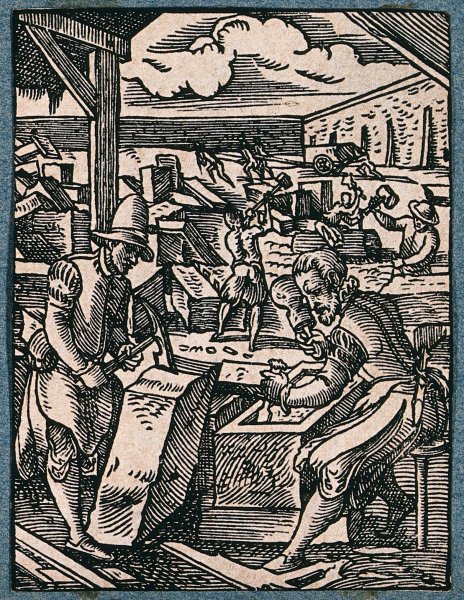
Stone masons working on blocks of stone, making cisterns, columns, building parts etc. Woodcut by J. Amman.
IMAGE LINKED: wellcome collection Attribution 4.0 International (CC BY 4.0)
This Charge belongeth to Apprentices.
Imprimis. YOU shall truly honour God, and his holy Church, the King, your Master, and Dame; you shall not absent yourself, but with the Licence of one or both of them, from their Service, by Day or Night.
II. You shall not Purloyn or Steal, or be Privy or accessary to the Purloyning or Stealing to the Value of Six-pence from them or either of them.
III. You shall not commit Adultery or Fornication in the House of your Master, with his Wife, Daughter or Maid.
IV. You shall not disclose your Master’s or Dame’s Secrets or Councils, which they have reported unto you, or what is to be concealed, spoken or done within the Privities of their House, by them, or either of them, or by any Free-Mason.
V. You shall not maintain any disobedient Argument with your Master, Dame, or any Free-Mason.
VI. You shall reverently behave your self towards all Free-Masons, using neither Cards, Dice, or any other unlawful Games, Christmas Time excepted.
VII. You shall not haunt, or frequent any Taverns or Ale-houses , or so much as go into any of them, except it be upon your Master or your Dame, their or any of their Affairs, or with their or the one of their Consents.
VIII. You shall not commit Adultery or Fornication in any Man’s House, where you shall be at Table or at Work.
IX. You shall not marry, or contract yourself to any Woman during your Apprenticeship.
X. You shall not steal any Man’s Goods, but especially your Master’s, or any of his Fellow Masons, nor suffer any to steal their Goods, but shall hinder the Felon, if you can; and if you cannot, then you shall acquaint the said Master and his Fellows presently.
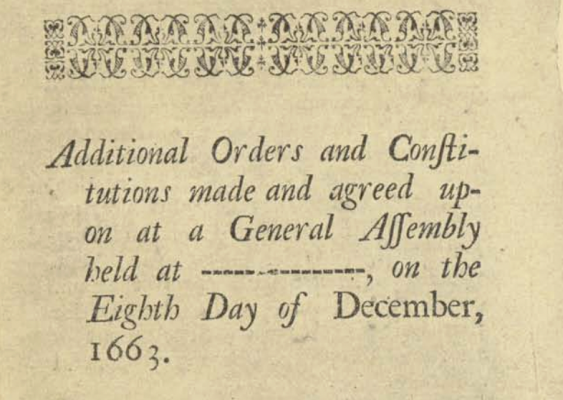
Additional Orders and Constitutions made and agreed upon at a General Assembly held at ————-, on the Eighth Day of December, 1663.
IMAGE LINKED: National Masonic Research Society, with an introduction by Masonic scholar Joseph Fort Newton in 1916. Attribution 4.0 International (CC BY 4.0)
Additional Orders and Constitutions made and agreed upon at a General Assembly held at ————-, on the Eighth Day of December, 1663.
I. THAT no Person, of what Degree soever, be accepted a Free-Mason, unless he shall have a Lodge of five Free-Masons at the least, whereof one to be a Master or Warden of that Limit or Division where such Lodge shall be kept, and another to be a Workman of the Trade of Free-Masonry.
II. That no Person hereafter shall be accepted a Free-Mason, but such as are of able Body, honest Parentage, good Reputation, and Observers of the Laws of the Land.
III. That no Person hereafter, which shall be accepted a Free-Mason, shall he admitted into any Lodge, or Assembly, until he hath brought a Certificate of the Time and Place of his Acception, from the Lodge that accepted him, unto the Master of that Limit and Division, where such Lodge was kept, which said Master shall enroll the same on Parchment in a Roll to be kept for that Purpose, and give an Account of all such Acceptions, at every General Assembly.
IV. That every Person, who is now a Free-Mason, shall bring to the Master a Note of the Time of his Acception, to the end the same may be enrolled in such Priority of Place, as the Person deserves, and to the end the whole Company and Fellows may the better know each other.
V. That for the future the said Society, Company and Fraternity of Free-Masons, shall be regulated and governed by one Master, and as many Wardens as the said Company shall think fit to chuse at every Yearly General Assembly.
VI. That no Person shall be accepted a Free-Mason, unless he be One and Twenty Years Old, or more.
VII. That no person hereafter be accepted a Free-Mason, or know the Secrets of the said Society, until he shall have first taken the Oath of Secrecy here following, viz.
I A. B. do here in the Presence of God Almighty, and of my Fellows and Brethren here present, promise and declare, That I will not at any Time hereafter by any or Circumstance whatsoever directly or indirectly, publish, discover, reveal or make known any of these Secrets, Privities or Councils of the Fraternity or Fellowship of Free Masons, which at this time, or at any time hereafter shall be made known unto me. So help me God, and the true and holy Contents of this Book.
F I N I S
Images of Roberts’ Constitutions courtesy of, and via: The Grand Lodge of Iowa
https://grandlodgeofiowa.org/docs/Law_Jurisprudence/RobertConstitutionsOf1722.pdf
Text extracted from a transcription via
https://freemasonry.bcy.ca/history/old_charges/robertsconstitutions1722.pdf
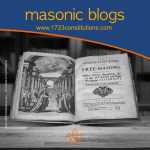
Masonic Blogs – 1723constitutions
1723constitutions.com/ masonic blog marks the tercentenary of the publication in London of The Constitutions of the Freemasons – the ‘1723 Constitutions’
more….
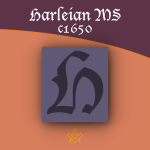
Harleian MS
There are two known ‘Harleian Manuscripts’ which allude to the earliest constitutions of Masonry.
more….
Recent Articles: masonic history
 Protestantism and Masonic Influence in Brazil Discover the untold story of how Freemasons helped Southern Americans immigrate to Brazil post-Civil War, fostering economic and educational growth in Santa Bárbara d’Oeste and Americana. Learn about their pivotal role in establishing Protestant churches and ensuring the secularity of the Brazilian State amidst a Catholic-dominated society. |
 Explore the proper use of the sacred word in Brazilian Freemasonry through an analysis of Masonic literature and Bible translations. Uncover the errors in pronunciation and the need for corrections to maintain liturgical coherence in rituals. Discover insights on Masonry, rituals, and the Hebrew word Boaz. |
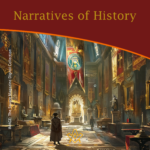 Narratives of History |
 A Very Royal Sesquicentenary |
 Unveiling the Enigma: Discover the Royal Society's Legacy and its Impact on Science. Delve into the fascinating history of the Royal Society, the prestigious UK academy shaping scientific progress since 1660. Explore its pivotal role in advancing knowledge, fostering collaboration, and unlocking the secrets of the universe. Prepare to be amazed! |
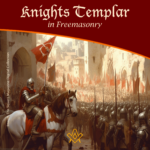 Knights Templar in Freemasonry Uncover the Mysteries of the Knights Templar in Freemasonry! Delve into the intriguing world where chivalry and symbolism intertwine. Discover the captivating rituals and ancient secrets behind the Knights Templar Masonic Orders. Explore the historical connection and delve into the enigmatic narratives that continue to fascinate enthusiasts today. Unveil the hidden truths now! |
 The Royal Arch stands as the rainbow of promise in the Ritual; it stands as the promise of the resurrection; of that which was lost and that it shall be recovered. The question arises as to whether the Master's Word was originally communicated in the Third Degree? On this point there is some diversity of opinion. Originally published in 1915, this insight into the Fourth Degree – the Holy Royal Arch – is as relevant today as it was over 100 years ago. |
 Unveiling the Mysteries of Druidism: Discover the Intriguing Connection with Freemasonry. Explore the ancient spiritual practice of Druidism and its fascinating ties to the enigmatic world of Freemasonry. Delve into the shared symbolism and rituals that have captivated minds for centuries. Unlock the secrets of these intertwined traditions today! |
 Uncover the legacy of freestone masons and their pivotal role in crafting medieval cathedrals. Discover the artistry behind their techniques, the hierarchy within their craft, and the enduring impact of their intricate carvings. A deep dive into the world of these master craftsmen awaits you! |
 Unearth the intriguing journey from Vincha Culture to Freemasonry. Discover how ancient building methods intertwine with modern Masonic philosophies. This exploration will shed light on the fascinating link between the Serbian term "shestarenye" and the symbolic significance of the compass in Freemasonry. |
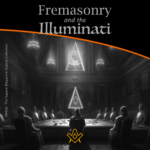 Freemasonry and the Illuminati Unravel the enigmatic world of Freemasonry and the Illuminati in our latest exposé. Dive into centuries-old mysteries, debunk conspiracy theories, and discover the truth behind these elusive societies. Are they puppet masters or mere myths? Join us as we dissect history and fact from fiction. |
 The Île des Templiers, or “Island of the Templars” lies within a leafy park in Paris. The execution site of Jacques du Molay, the last Grand Master of the Knights’ Templar bears a plaque with the epitaph ‘A cet endroit / Jacques de Molay / Dernier grand maître / de l'ordre du temple / a été brûlé le 18 Mars 1314’ (‘In this location / Jacques de Molay / Last grand master / of the order of the temple / was burned on 18 March 1314’) |
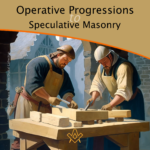 Operative Progressions to Speculative Masonry Both Operative and Speculative Masonry are an important part of the modern fraternity of Freemasonry, which combines elements of both traditions. Today, Freemasonry is a fraternity that is open to men of good character, who are interested in personal development and in making a positive contribution to their communities. |
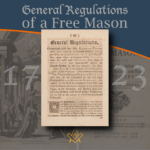 General Regulations of a Free Mason, 1723 General Regulations of a Free Mason as contained in Anderson's Constitutions of the Freemasons, published 1723. the Regulations are of great historical interest. Compiled by George Payne, the second Grand Master of the Premier Grand Lodge of England, they were printed in 1722/3, thus published just over five years after the formation of the Grand Lodge 1717. |
 The Genesis of the 1723 Book of Constitutions 2023, marks the three hundredth anniversary of the publication of the first printed Book of Constitutions of the Grand Lodge formally established in London two years previously. This is an anniversary whose significance extends beyond freemasonry. A paper by Andrew Prescott |
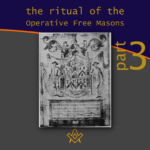 The Ritual of the Operative Free Masons - P3 Existing Operative Free Masons. The ritual I am about to refer, is that of "The Worshipful Society of Free Masons, Rough Masons, Wallers, Slaters, Paviors, Plaisterers, and Bricklayers." By Thomas Carr, M.D., P. M. Honorary Member of the Guild of Operative Free Masons |
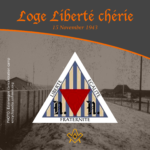 Liberté chérie was a Masonic Lodge founded in 1943 by Belgian Resistance fighters and other political prisoners at Esterwegen concentration camp. It was one of the few lodges of Freemasons founded within a Nazi concentration camp during the Second World War. |
 The Ritual of the Operative Free Masons - P2 If anyone doubts the fact that the formation of Speculative Free Masonry was due to and based upon Operative Free Masonry, it is quite easy to convince him of his error if he will only study the first Book of Constitutions. By Thomas Carr, M.D., P. M. Honorary Member of the Guild of Operative Free Masons |
 In 1881, Freemasonry rose from the ashes of a fire in the mining town of Kokomo, Summit County, Colorado. Corinthian Lodge No. 42, along with Kokomo, no longer exists but it holds the record of having been – at an elevation of 10,618 feet – the highest Masonic Lodge in the USA. |
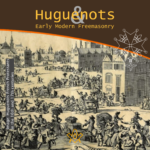 The Huguenots and Early Modern Freemasonry The Huguenots influence in the development of early modern Freemasonry at the time of the formation of the Grand Lodge in London around 1717 / 1723. |
 November is a month of reflection – perhaps due to the fact that we are getting close to the years' end – but also because Remembrance / Armistice Day (11 November) is a significant date in most countries' diaries. |
 Speculative Freemasonry, as practise by Grand Lodge of England, was officially born just over three hundred years ago, is today an international organisation, counting over six million members. It has been subjected to persecution, suppression, and abolition throughout its history. In its infancy, only a couple of decades after its official birth, it had already become a target. |
 The Ritual of the Operative Free Masons - P1 The original paper was written, first, to prove that Speculative Free Masonry was derived from Operative Free Masonry; second, to give some account of the Operative Free Masons, of their Ritual, and of their customs. By Thomas Carr, M.D., P. M. Honorary Member of the Guild of Operative Free Masons |
 American Fraternalism in the 19th and Early 20th Centuries The late 19th and early 20th centuries in the United States has been called the "Golden Age of Fraternalism." How did this come about and why was the idea of joining a fraternal organization so popular? We will explore this question and examine the regalia used by many fraternal organizations in this period. |
 Societas Draconistarum, meaning "Society of the Dragonists"– was a chivalric Order for selected nobility, founded in 1408 by Sigismund von Luxembourg, who through marriage became the King of Hungary (1387–1437) and later Holy Roman Emperor. The Order was fashioned after the military orders of the Crusades, requiring its initiates to defend the cross and fight the enemies of Christianity, in particular the Ottoman Empire. |
 The Perjured Free Mason Detected Was Samuel Prichard a perjured individual, or simply a misguided Freemason? Prichard's book "Free Masonry Dissected" published in 1730, is now used by many Masonic historians as a source of reference with regards to the introduction of the third degree into the Craft. But at the time it was published in 1730, it was not so well received by members of the Grand Lodge of England. |
 17th century and the Holy Royal Arch This article focuses on a period of transition between a point in time when we can safely and historically identify the first formation of what could be called as the ‘Royal Arch’ and the historical events that have preceded it. |
 Most Freemasons have heard the terms 'Operative' and 'Speculative' Masons, and this article helps to understand the difference: |
 Roberts' Constitutions of Freemasonry 1722 Published a year before Anderson's Constitutions, The Old Constitutions Belonging to the Ancient and Honourable SOCIETY OF Free and Accepted MASONS. Originally printed in London England; Sold by J. Roberts, in Warwick-Lane, MDCCXXII.(1722) |
 From 'Songs of religion and life', 1876 by John Stuart Blackie (1809-1895) |
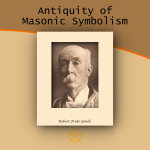 On the Antiquity of Masonic Symbolism Is the Symbolism of Masonry an inheritance derived from the old Masons who flourished before the era of the Grand Lodges (1717); or has it been borrowed from the Rosicrucians or others, after 1717? |
 Mason's Marks – from Egypt to Europe? Mason's marks have been a source of intrigue, not only to Freemasons but to historians and archaeologists. The use of simple pictograms have been employed for millennia by artisans to identify their work. But where did they originate and why? |
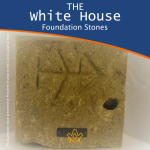 The White House Foundation Stones Further to the articles in our series on the history of the stone masons, we have a rather intriguing addition. During the 1950's renovation of the White House, President Truman retrieved more than 100 stone blocks with stonemasons marks. |
 What the Goose and Gridiron Tavern is in the ancient annals of London Freemasonry, The Green Dragon Tavern is to the memories of the Free-mason, of Boston and New England. |
 Auschwitz concentration camp: video photo article taken in 2013 |
 There are two things of importance happening this day - 27 January |
 Two approaches regarding the understanding of Freemasonry |
 Masonic Research in England c1930 An article which appeared in an American Masonic magazine, c1930 and which was reproduced in England, provoking a little controversy. |
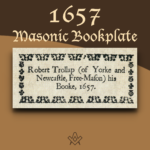 Masonic bookplates the ‘Brethren’s spiritual coats of arms and marks’ |
 The Unlawful Societies Act of 1799 Rebellious Freemasons and the 21st century |
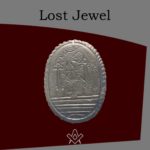 In 1912, Sarah Dowd of Dromore, Ireland, found a Masonic jewel dated 1517 - a date two hundred years before the establishment of Grand Lodge... |
 Freemasonry and Fascist Regime Interesting speech by the famous historian Prof. Aldo A. Mola, who links the fascist regime with the Masonic Associations. |
 Was famous Russian poet Alexander Pushkin a Freemason? And if so, was he a member of the lodge ‘for which all the lodges in Russia were destroyed’? |
 The Importance of Masonic Research Why is accurate - or authentic - Masonic research so important? The importance of making a daily advancement in Masonic knowledge is something that The Square is passionate about promoting. |
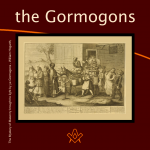 The Antient Noble Order of the Gormogons had a brief existence in the eighteenth century; they left few records or accomplishments, |
masonic knowledge
to be a better citizen of the world
share the square with two brothers

click image to open email app on mobile device



